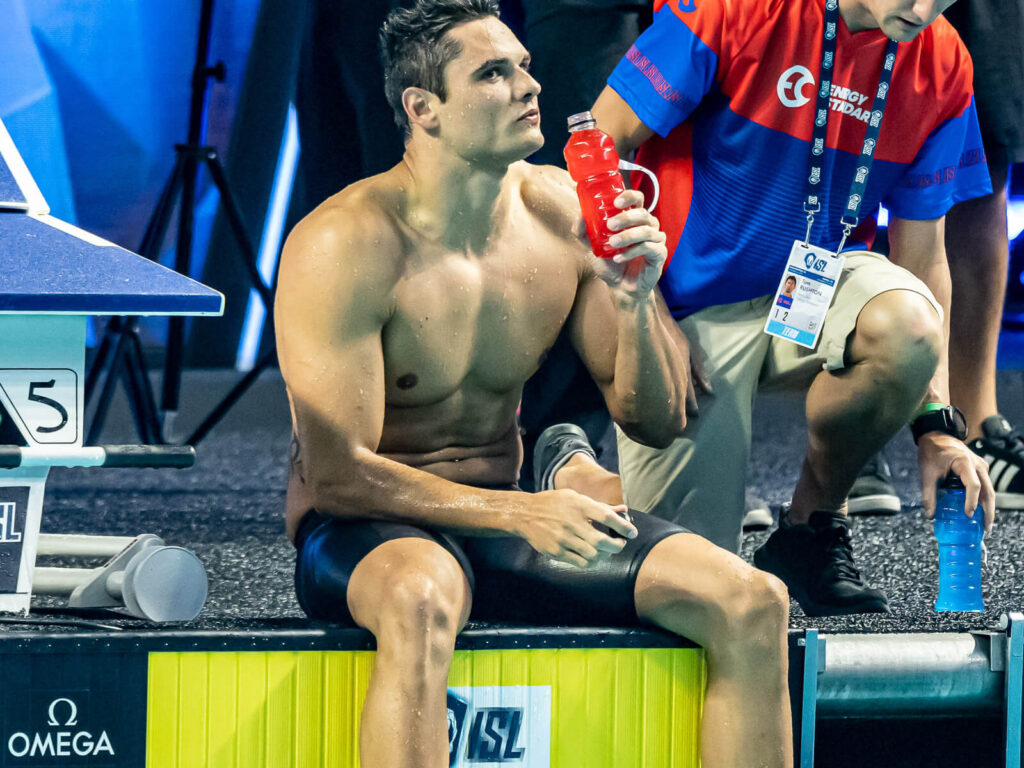
Image Courtesy: Swimming World

Image Courtesy: Swimming World
The correct management of aerobic and anaerobic sets within a swimmer’s training will influence performance. This balance includes sharpening cardiovascular endurance and sprint speed. For instance, sprinters are more anaerobic-oriented. On the other hand, distance swimmers rely on the benefits of aerobic sets. In analyzing these types of workouts, the primary difference between aerobic and anaerobic exercise is the workout’s intensity.
Swimmers increase their cardiovascular conditioning by maximizing the amount of oxygen in the blood. The goal is to build cardiovascular conditioning and improve the muscles’ oxidative capacity. For that reason, athletes should perform the sets at a moderately high intensity with minimum recovery between sets. However, since swimmers can consistently breathe and send oxygen through their bodies, aerobic workouts are categorized as “less stressful.” Subsequently, since oxygen is the main source of energy, swimmers should breathe faster and deeper when their heart rate is at rest. Subsequently, athletes can do aerobic workouts for longer periods.
Aerobic training is fundamental at the beginning of the season, approximately during the first eight to 12 weeks. Following this training approach will prepare athletes for high-intensity workouts and competitions that arise later in the season. Meanwhile, some of the benefits of aerobic exercise include an increase in a swimmer’s stamina and a decrease in fatigue during exercising. Equally important, aerobic workouts also improve a swimmer’s ability to perform more efficient strokes with less energy.
The purpose of anaerobic exercise is to improve the muscles’ ability to lessen lactate. Lactate, also known as lactic acid, is a byproduct produced in the body after cells produce energy without oxygen around. Furthermore, during this process, the body grabs energy through glycogen. Glycogens are stored calories that the body uses when oxygen is not being pumped to the muscles to continue working out.
Anaerobic sets involve short-distance and high-intensity intervals. These strength-based workouts also include exerting a swimmer’s maximum effort. Since it is fundamental to reach maximum effort within the sets, anaerobic workouts can include long periods of rest. Then again, due to their high physical and mental demand, anaerobic sets sometimes are considered “more stressful.”
When done properly, anaerobic workouts benefit a swimmer’s muscle strength and mass, reduce soreness, and boost joint protection.
These sets occur when the athlete holds 1650 yards or 30 minutes (without stopping) pace. While doing so, the swimmer should tolerate the buildup of lactate. To sum up, a threshold set is a long workout in which the swimmer must speed through the set. For that reason, the required effort should be located between the aerobic and anaerobic zones.
Some of the benefits of doing thresholds include improving the swimmer’s stamina, the ability to process lactate, generating aerobic fitness and developing anaerobic explosiveness. Consequently, swimmers will be able to perform more repetitions of high intensity. The threshold set gives the swimmer a better idea of what the desired race pace feels like.
Usually, sprinters do not feel the need to perform aerobic sets. In the same way, long-distance swimmers may exclude anaerobic workouts. However, swimming has evolved and its training methods, too. Therefore, new training phases have emerged such as the threshold. It is best for coaches and swimmers to identify the correct balance between aerobic, anaerobic and threshold workouts. Additionally, it is fundamental that each swimmer keeps straight communication with his or her coach to avoid burnout, injuries and overtraining.